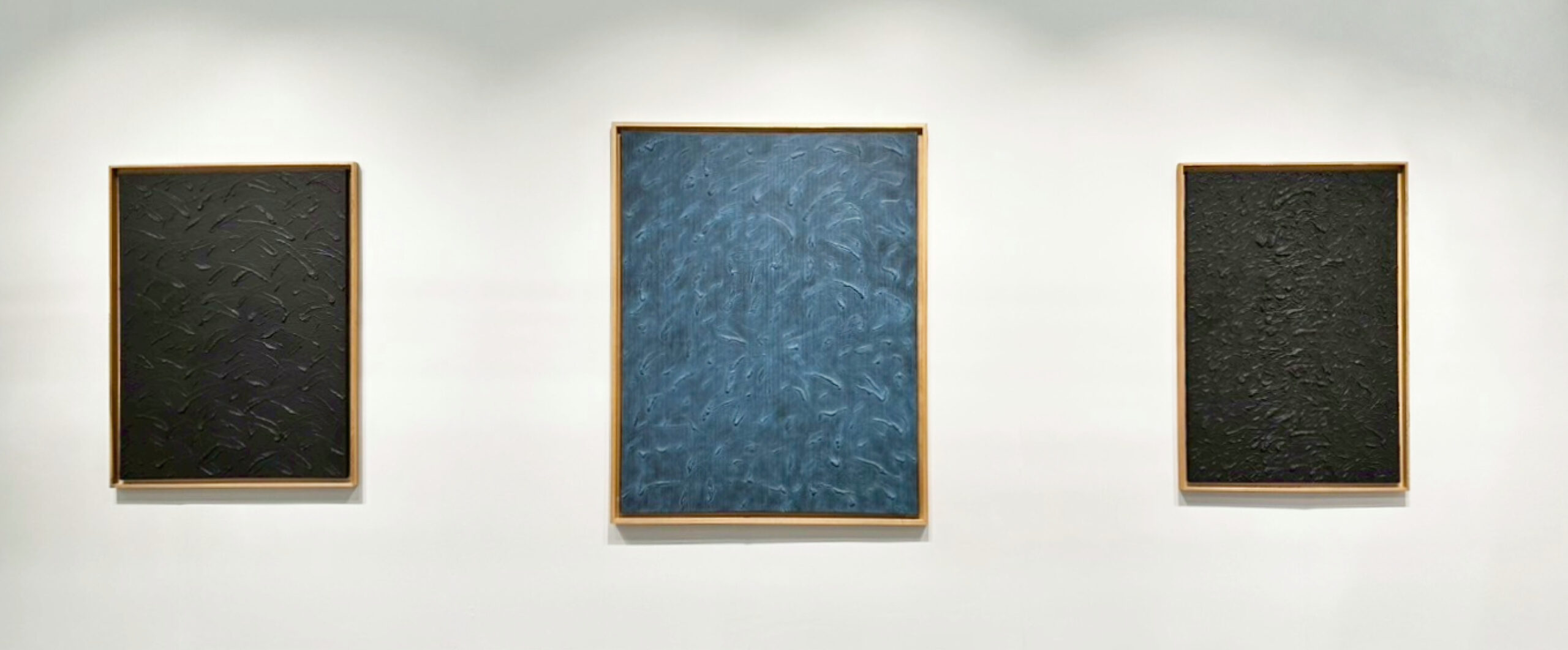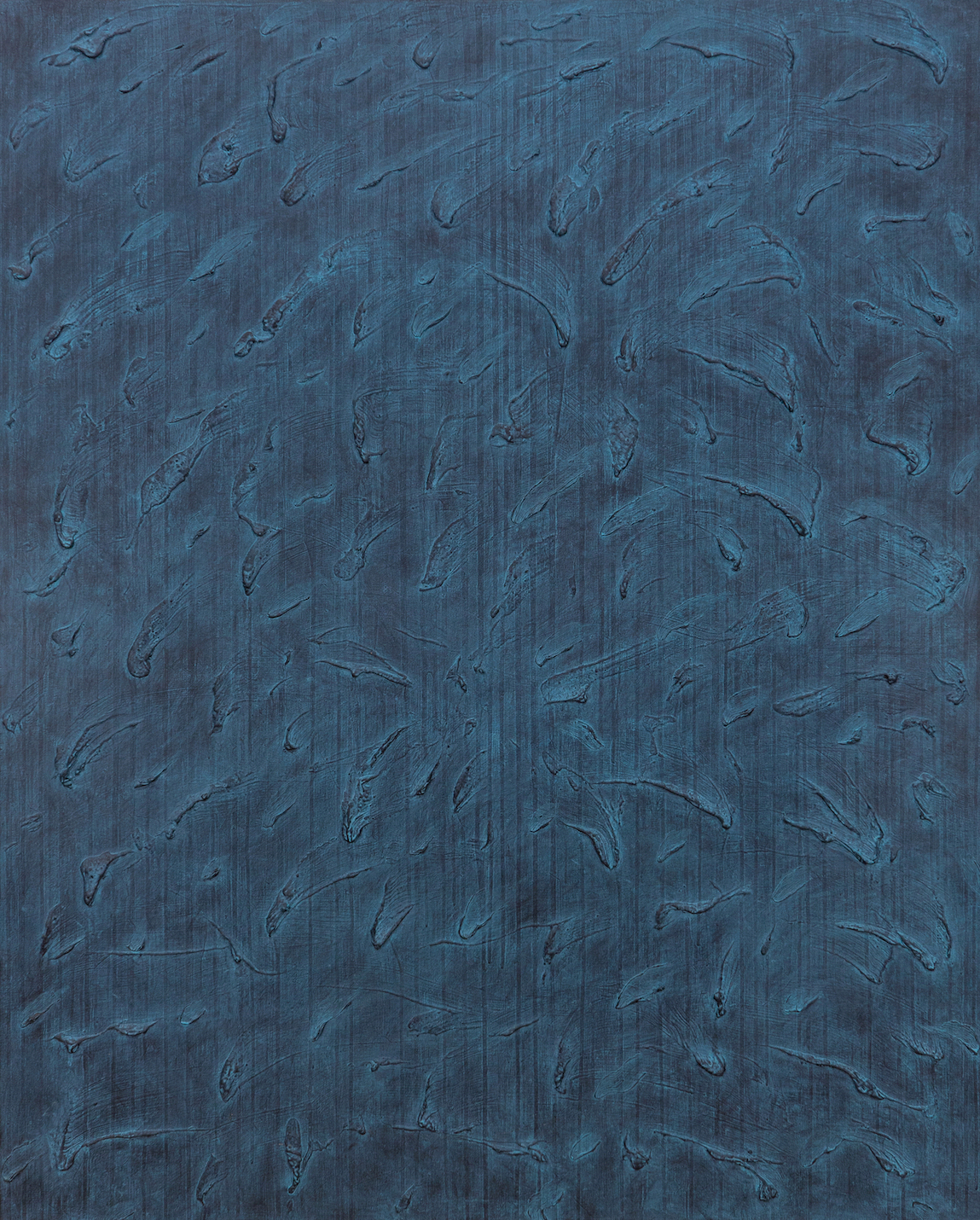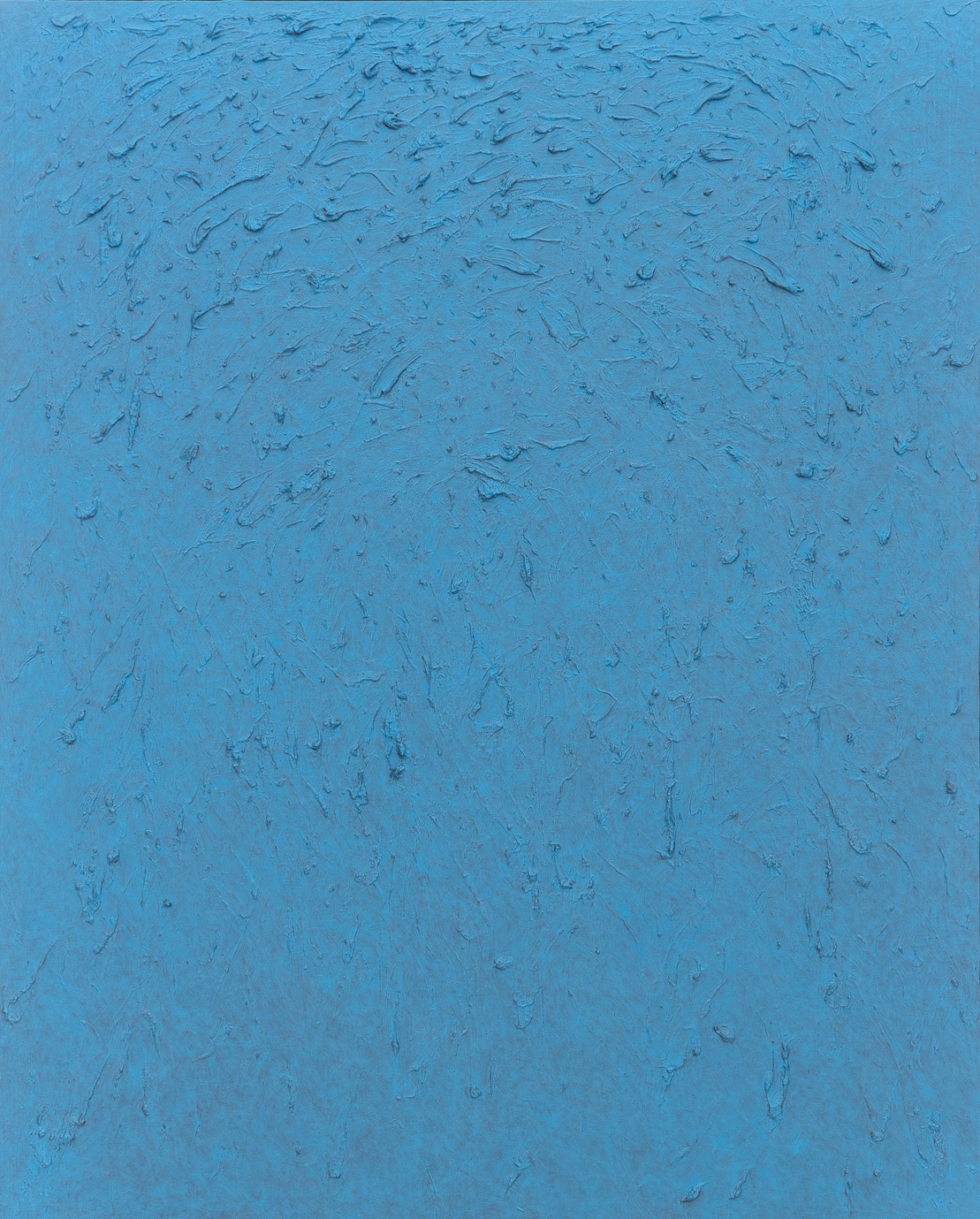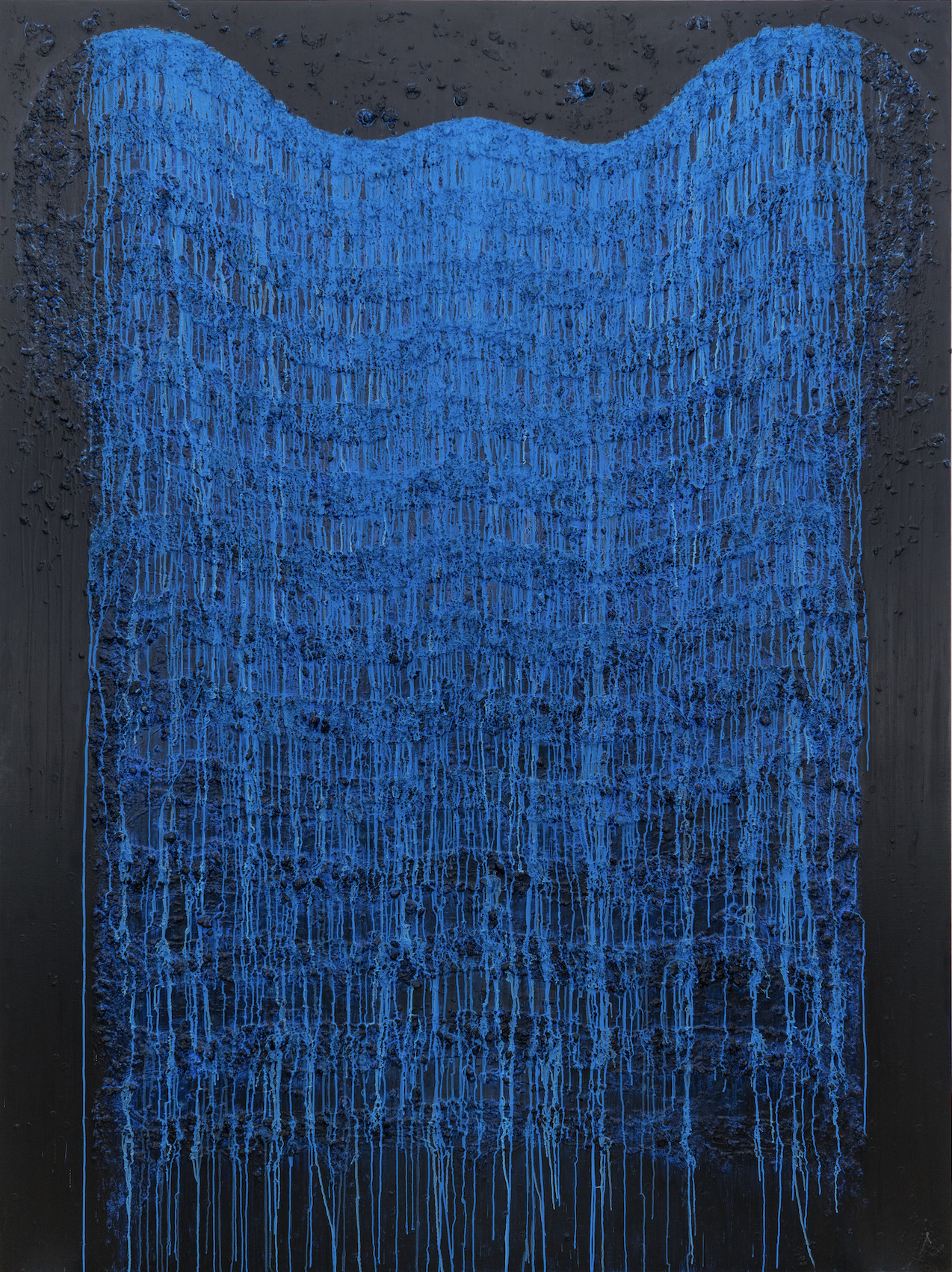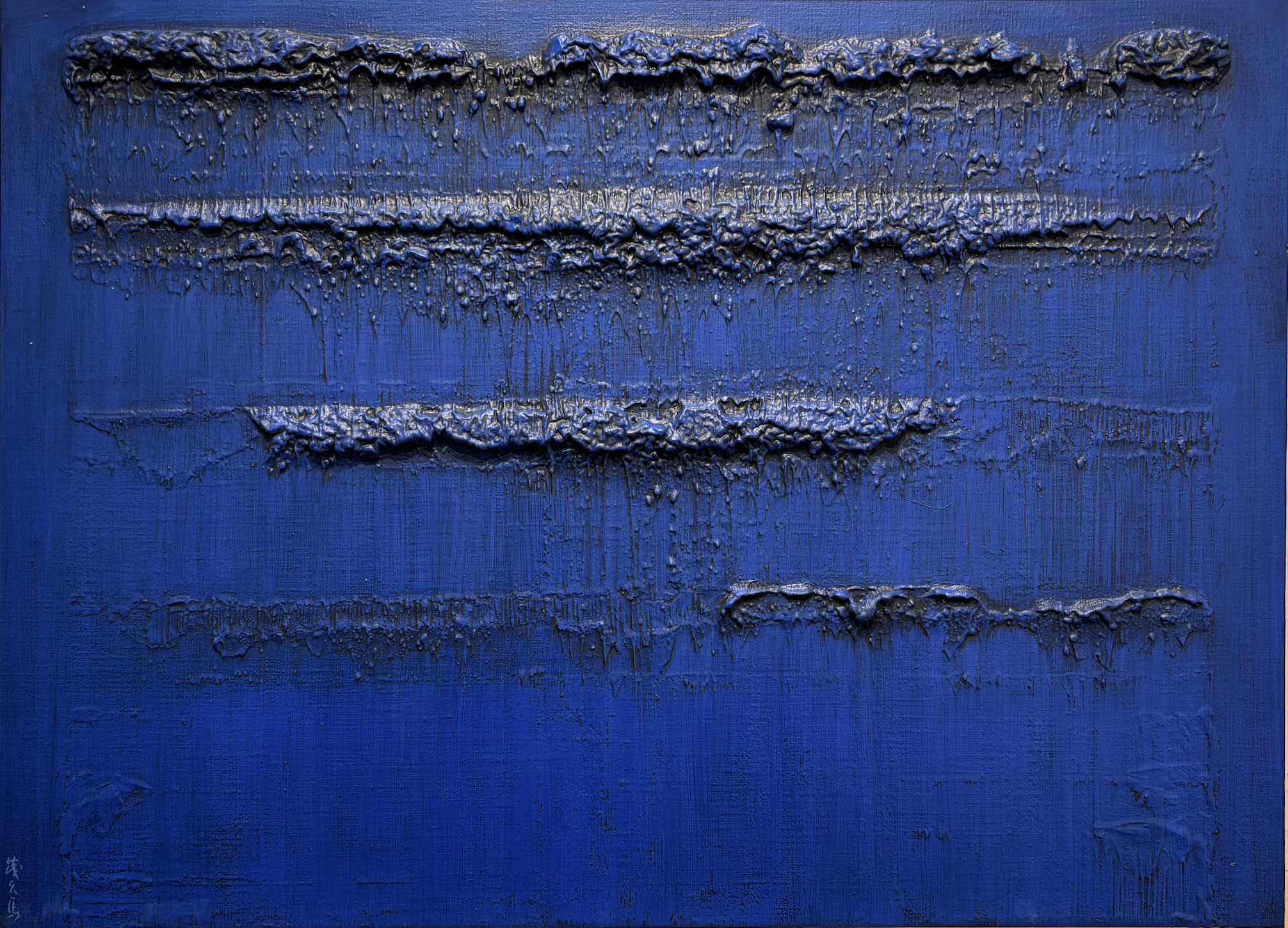KIKUHATA Mokuma
菊畑茂久馬
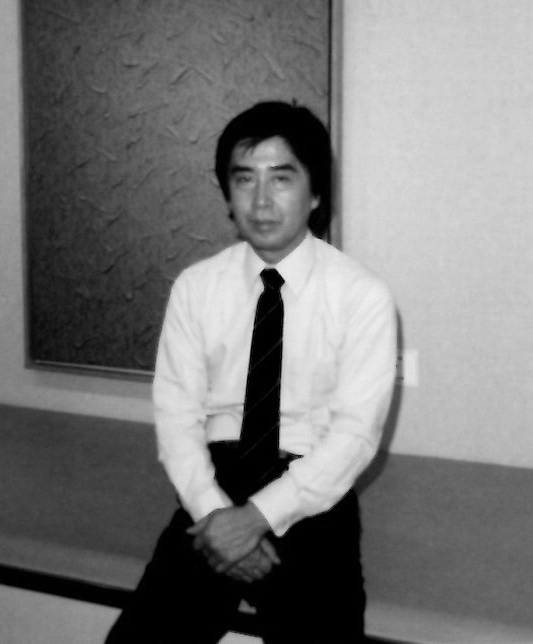
MOKUMA KIKUHATA
Artist. Born in Nagasaki Prefecture
One of the leading writers of postwar avant-garde art in 1935-2020
He participated in the launch of the "Kyushu-ha" in 1957. He released works against academia and became an avant-garde artist Hope. In 1964, the "Roulette" series was highly regarded in the United States as a pioneer of Japanese pop art. In 1983, he released a series of "Geocentric Theory" , amd since then he released a series of large scale-paintings such as "Moonlight", "Tsukimiya", "Ocean Current", "Sea Warm / Cold Current", "Barcarolle", "Tenkawa", and "Spring Wind". He also studied the connection between the history of modern Japan and paintings, and published many books. In addition to that, he also contributed to the evaluation and introduction of Sakubei Yamamoto, a coal mine record painter who was registered as a UNESCO memory heritage for the first time in Japan.
He moved to Fukuoka City in 1941 (Showa 16) and graduated from Fukuoka Prefectural Chuo High School in 1953.
In 1956, he exhibited a cubism oil painting "Two People" at the "24th Independent Exhibition" and it was awarded. At the following year 1957, he participated in the launch of the avant-garde art group "Kyushu-ha", and exhibited some work at the 10th Yomiuri Independent Exhibition (Tokyo Metropolitan Art Museum) in 1958. He left the "Kyushu-ha" in 1960 and established the "cave school" in the same year. In 1961, he presented his early masterpiece "Slave Genealogy" series at the "Experiment of Contemporary Art" exhibition (National Museum of Modern Art). The work, which embodies an extremely magical and earthly expression of desire, expresses the tactile sensation of matter and the sense of reality of things, from the construction of a two-dimensional image in previous paintings by using three-dimensional work = installation. This work has emerged a scandalous reputation and become one of the representative works in Japanese expression tendency in 1960, which denies and destroys established artistic ideas such as the Neo-Dada movement and “anti-art.” In 1964, he started working on "Botanical Encyclopedia" following to the "Roulette" series. He focused on separating the attributes of things that surround everyday life and paying attention to their simplified symbolism. He has created a method that can be called "painting by objects" that expresses the dissociation between the function of the thing and the image by three-dimensionally integrating the objects and using the assemblage method. It is a condensed version of personal memory and introspective thinking, but the impression of the work is more like "indigenous pop art." Since the latter half of the 1960s, he has concentrated on the production of large and small objects, and he has taken pictures of the objects and printed on silk screen to publish a collection of works "Geocentric theory" in 1974. Since 1983, he has produced series such as "Moonlight" and "Kaido", including "Tendo Theory", a masterpiece of large-screen series paintings mainly on oil paintings, and announced "Tenkawa" in 1996 (Heisei 8). Since then, he has released a large group of works in the series. These masterpiece series are a synthesis of the relationship between physicality and illusion, and flatness and illusion, which he had explored in object works and prints, on the screen of the painting. His original method of swallowing an object on a flat surface and absorbing it into the painting skin was highly evaluated. He announced "Spring Song", which follows the flow of the "Spring Wind" series announced in 2011, at Kaikai Kiki Gallery in 2015. The trapezoidal form and pastel color of the work expressed not only imposing lyricism but also the life in the deep back, and it became a controversial topic.
【Chronology】
1954 Obtained a job painting at the Rakuyaki section of Iwataya Department Store (Fukuoka City)
1956 The 24th Dokuritsu Exhibition(Tokyo Metropolitan Art Museum, Tokyo)
1957–1962 Belonged to Kyushu-ha(Withdrew temporarily in 1959 to form Dokutsu-ha)
1958 The 10th Yomiuri Independent Exhibition(Tokyo Metropolitan Art Museum, Tokyo)
First Solo Exhibition(The Gallery of Iwataya Department Store, Fukuoka)
Kyushu-ha Group Exhibition(Ginza Gallery, Tokyo)
1960 The 12th Yomiuri Independent Exhibition(Tokyo Metropolitan Art Museum, Tokyo)
Dokutsu-ha Exhibition(Ginza Gallery, Tokyo)
1961 The 13th Yomiuri Independent Exhibition, Slave Genealogy, coin(Tokyo Metropolitan Art Museum, Tokyo)
Adventure in Today’s Art of Japan, Slave Genealogy, coin(National Museum of Modern Art, Tokyo)
1962 Solo Exhibition, Slave Genealogy – Disc Mirror(Minami Gallery, Tokyo)
1964 Young Seven, Roulette(Minami Gallery, Tokyo)
Solo Exhibition, Roulette(Minami Gallery, Tokyo)
Get acquainted with Sakubei Yamamoto
1965 The New Japanese Painting and Sculpture(Museum of Modern Art, New York, and eight other museums in USA)
The 2nd Nagaoka Museum of Contemporary Art Award(Nagaoka Museum of Contemporary Art, Niigata)
1967 Kyushu / Tendency of Contemporary Art(Fukuoka Culture Hall, Fukuoka)
1968 Anti-war and Liberation(Nihon Gallery, Tokyo), Object artworks unveiled for the first time
1969 The 3rd Kyushu / Tendency of Contemporary Art(Fukuoka Culture Hall, Fukuoka)
The 4th Japan Art Festival(National Museum of Modern Art, Tokyo / Museum of Asian Arts, Paris, France)
1970 Started teaching at Bigakko School, Tokyo(–2001)
1973 Published Sakubei Yamamoto Collection of Works “Chikuho Coal Mine Paintings”
1974 Solo Exhibition, Ptolemaic Theory(Gallery Shunju, Tokyo and four other galleries in Japan)
1978 Published “Foujita, Sleep and The Emperor's Art”
1981 Solo Exhibition, Object Drawing(Fukuoka Art Museum, Fukuoka)
Screenplay and composition for TV program “Ekaki to Senso (Painters and the War)”, broadcast on RKB Mainichi Broadcasting Corp.
The 1960s: A Decade of Change of Contemporary Japanese Art(National Museum of Modern Art, Tokyo and Kyoto)
1983 Trends of Japanese Art in the 1960s(Tokyo Metropolitan Art Museum, Tokyo)
Solo Exhibition, Ptolemaic Theory(Tokyo Gallery, Tokyo)
1984 Solo Exhibition, Ptolemaic Theory(Ten Gallery, Fukuoka)
Human Documents '84 / '85(Tokyo Gallery, Tokyo)
1985 Japanese Contemporary Paintings(National Museum of Modern Art, New Delhi, India)
40 Years of Japanese Contemporary Art(Tokyo Metropolitan Art Museum, Tokyo)
Reconstructions: Avant-Garde Art in Japan 1945–1965(The Museum of Modern Art, Oxford, U.K.)
1986 Solo Exhibition, Moonlight(Tokyo Gallery, Tokyo)
Japon des Avant-Gardes 1910–1970(Centre Georges Pompidou, Paris, France)
1987 PAINTING 1977–1987(The National Museum of Art, Osaka)
1988 GROUP KYUSHU-HA:ANTI-ART PROJECT(Fukuoka Art Museum, Fukuoka)
Kikuhata Mokuma Exhibition(Kitakyushu Municipal Museum of Art, Fukuoka)
1989 Awarded at the 14th Fukuoka City Cultural Award
1990 Solo Exhibition, Way to Sea(Tokyo Gallery, Tokyo)
1991 Solo Exhibition, Sea – Cold Current, Sea – Warm Current(Gallery Kasahara, Osaka)
1993 Solo Exhibition, Chantey(Tokyo Gallery, Tokyo)
1994 Japanese Art After 1945: Scream Against the Sky(Guggenheim Museum Soho, New York / San Francisco Museum of Modern Art, San Francisco, U.S.)
1996 1964: A Turning Point in Japanese Art(Museum of Contemporary Art Tokyo, Tokyo)
Solo Exhibition, Heavenly River(Gallery Kasahara, Osaka)
1997 Awarded at the 56th Western Japan Culture Awards
1998 Mokuma Kikuhata: 1983–1998 To the Heaven, To the Sea(The Tokushima Modern Art Museum, Tokushima)
Art in Fukuoka at the Postwar Period(Fukuoka Art Museum, Fukuoka)
1999 Solo Exhibition, Heavenly River(Tokyo Gallery, Tokyo)
2001 Solo Exhibition, Sea Palace(Gallery Kasahara, Osaka)
2002 The Unfinished Century: Legacies of 20th Century Art(National Museum of Modern Art, Tokyo)
ATTITUDE 2002(Contemporary Art Museum, Kumamoto)
2003 The Power of Kyushu: World Art Born on the Island Kyushu(Contemporary Art Museum, Kumamoto)
2004 Remaking Modernism in Japan 1900–2000(Museum of Contemporary Art Tokyo / The University Art Museum, Tokyo)
Awarded at the 3rd Enku Grand Awards
Visiting Professor at Aichi University of the Arts(–2007)
Modern Means | Continuity and Change in Art, 1880 to the Present(Mori Art Museum, Tokyo)
Marcel Duchamp and 20th Century Art(The National Museum of Art, Osaka / Yokohama Museum of Art, Kanagawa)
2005 Age of Tokyo Metropolitan Art Gallery: 1926–1970(Museum of Contemporary Art Tokyo, Tokyo)
2007 Solo Exhibition, Spring Breeze(Art Gallery Kan, Tokyo)
Kikuhata Mokuma to Monogataru Objet(Fukuoka Prefectural Museum of Art, Fukuoka)
2009 The Coal Mine as Cultural Resource: Art / Photography / Graphic Arts / Film of Japanese Coal Mines(Meguro Museum of Art, Tokyo)
Kikuhata Mokuma: Drawing(Nagasaki Prefectural Art Museum, Nagasaki)
2010 Chronicle 1947–1963 Days of Independent Art Exhibitions(Museum of Contemporary Art Tokyo, Tokyo)
2011 Kikuhata Mokuma Postwar / Painting(Fukuoka Art Museum, Fukuoka / Nagasaki Prefectural Art Museum, Nagasaki)
Awarded at the 53rd Mainichi Art Awards
2012 Solo Exhibition, Sky, Sea, Wind(Fukuoka Art Museum, Fukuoka)
2012–2013 Art Will Thrill You!:The Essence of Modern Japanese Art(National Museum of Modern Art, Tokyo)
2013 Tokyo 1955–1970: A New Avant-Garde(The Museum of Modern Art, New York)
2015 Mokuma Kikuhata: A Song for Spring(Kaikai Kiki Gallery, Tokyo)
2016 Takashi Murakami’s Superflat Collection―From Shōhaku and Rosanjin to Anselm Kiefer―(Yokohama Museum of Art, Kanagawa)
2020 Mokuma Kikuhata: The World of the Painting(Fukuoka Art Museum, Fukuoka)
Mokuma Kikuhata: The Path Leading to Painting(Nagasaki Prefectural Art Museum, Nagasaki)
Passed away at the age of 85
2022 KIKUHATA Mokuma Exhibition(Dazaifu Tenmangu Homotsuden, Fukuoka)
2023 MOKUMA KIKUHATA TENDOSETSU 1983–1985(Contemporary HEIS, Tokyo)
ART FAIR TOKYO 2023(Tokyo International Forum, Tokyo)
2024 MOKUMA KIKUHATA BLUE ABYSS 1985–2000, ART FAIR TOKYO 2024(Tokyo International Forum, Tokyo)
2025 The Armory Show 2025(Javits Center, New York)
Kikuhata Mokuma Exhibition(Fukuoka Art Museum, Fukuoka)
【 PUBLIC COLLECTIONS 】
The Museum of Modern Art (MoMA), New York, USA
The National Museum of Modern Art, Tokyo (MOMAT), Tokyo, Japan
Museum of Contemporary Art Tokyo, Tokyo, Japan
National Museum of Art, Osaka, Japan
Fukuoka Art Museum, Fukuoka, Japan
Fukuoka Prefectural Museum of Art, Fukuoka, Japan
Kitakyushu Municipal Museum of Art, Kitakyushu, Japan
Nagasaki Prefectural Art Museum, Nagasaki, Japan
Hiroshima City Museum of Contemporary Art, Hiroshima, Japan
Contemporary Art Museum Kumamoto, Kumamoto, Japan
Tokushima Prefectural Museum of Modern Art, Tokushima, Japan
Aomori Museum of Art, Aomori, Japan
Miyagi Museum of Art, Sendai, Japan
Takamatsu City Museum of Art, Takamatsu, Japan
The Museum of Art, Kochi, Japan
Utsunomiya Museum of Art, Utsunomiya, Japan
Itabashi Art Museum, Tokyo, Japan
Chiba City Museum of Art, Chiba, Japan
Hyogo Prefectural Museum of Art (Yamamura Collection), Kobe, Japan
Iwaki City Art Museum, Iwaki, Japan
Tagawa Museum of Art, Tagawa, Japan
Dazaifu Tenmangu Homotsuden (Treasure Hall), Dazaifu, Japan
Artist. Born in Nagasaki Prefecture
One of the leading writers of postwar avant-garde art in 1935-2020
He participated in the launch of the "Kyushu-ha" in 1957. He released works against academia and became an avant-garde artist Hope. In 1964, the "Roulette" series was highly regarded in the United States as a pioneer of Japanese pop art. In 1983, he released a series of "Geocentric Theory" , amd since then he released a series of large scale-paintings such as "Moonlight", "Tsukimiya", "Ocean Current", "Sea Warm / Cold Current", "Barcarolle", "Tenkawa", and "Spring Wind". He also studied the connection between the history of modern Japan and paintings, and published many books. In addition to that, he also contributed to the evaluation and introduction of Sakubei Yamamoto, a coal mine record painter who was registered as a UNESCO memory heritage for the first time in Japan.
He moved to Fukuoka City in 1941 (Showa 16) and graduated from Fukuoka Prefectural Chuo High School in 1953.
In 1956, he exhibited a cubism oil painting "Two People" at the "24th Independent Exhibition" and it was awarded. At the following year 1957, he participated in the launch of the avant-garde art group "Kyushu-ha", and exhibited some work at the 10th Yomiuri Independent Exhibition (Tokyo Metropolitan Art Museum) in 1958. He left the "Kyushu-ha" in 1960 and established the "cave school" in the same year. In 1961, he presented his early masterpiece "Slave Genealogy" series at the "Experiment of Contemporary Art" exhibition (National Museum of Modern Art). The work, which embodies an extremely magical and earthly expression of desire, expresses the tactile sensation of matter and the sense of reality of things, from the construction of a two-dimensional image in previous paintings by using three-dimensional work = installation. This work has emerged a scandalous reputation and become one of the representative works in Japanese expression tendency in 1960, which denies and destroys established artistic ideas such as the Neo-Dada movement and “anti-art.” In 1964, he started working on "Botanical Encyclopedia" following to the "Roulette" series. He focused on separating the attributes of things that surround everyday life and paying attention to their simplified symbolism. He has created a method that can be called "painting by objects" that expresses the dissociation between the function of the thing and the image by three-dimensionally integrating the objects and using the assemblage method. It is a condensed version of personal memory and introspective thinking, but the impression of the work is more like "indigenous pop art." Since the latter half of the 1960s, he has concentrated on the production of large and small objects, and he has taken pictures of the objects and printed on silk screen to publish a collection of works "Geocentric theory" in 1974. Since 1983, he has produced series such as "Moonlight" and "Kaido", including "Tendo Theory", a masterpiece of large-screen series paintings mainly on oil paintings, and announced "Tenkawa" in 1996 (Heisei 8). Since then, he has released a large group of works in the series. These masterpiece series are a synthesis of the relationship between physicality and illusion, and flatness and illusion, which he had explored in object works and prints, on the screen of the painting. His original method of swallowing an object on a flat surface and absorbing it into the painting skin was highly evaluated. He announced "Spring Song", which follows the flow of the "Spring Wind" series announced in 2011, at Kaikai Kiki Gallery in 2015. The trapezoidal form and pastel color of the work expressed not only imposing lyricism but also the life in the deep back, and it became a controversial topic.
【Chronology】
1954 Obtained a job painting at the Rakuyaki section of Iwataya Department Store (Fukuoka City)
1956 The 24th Dokuritsu Exhibition(Tokyo Metropolitan Art Museum, Tokyo)
1957–1962 Belonged to Kyushu-ha(Withdrew temporarily in 1959 to form Dokutsu-ha)
1958 The 10th Yomiuri Independent Exhibition(Tokyo Metropolitan Art Museum, Tokyo)
First Solo Exhibition(The Gallery of Iwataya Department Store, Fukuoka)
Kyushu-ha Group Exhibition(Ginza Gallery, Tokyo)
1960 The 12th Yomiuri Independent Exhibition(Tokyo Metropolitan Art Museum, Tokyo)
Dokutsu-ha Exhibition(Ginza Gallery, Tokyo)
1961 The 13th Yomiuri Independent Exhibition, Slave Genealogy, coin(Tokyo Metropolitan Art Museum, Tokyo)
Adventure in Today’s Art of Japan, Slave Genealogy, coin(National Museum of Modern Art, Tokyo)
1962 Solo Exhibition, Slave Genealogy – Disc Mirror(Minami Gallery, Tokyo)
1964 Young Seven, Roulette(Minami Gallery, Tokyo)
Solo Exhibition, Roulette(Minami Gallery, Tokyo)
Get acquainted with Sakubei Yamamoto
1965 The New Japanese Painting and Sculpture(Museum of Modern Art, New York, and eight other museums in USA)
The 2nd Nagaoka Museum of Contemporary Art Award(Nagaoka Museum of Contemporary Art, Niigata)
1967 Kyushu / Tendency of Contemporary Art(Fukuoka Culture Hall, Fukuoka)
1968 Anti-war and Liberation(Nihon Gallery, Tokyo), Object artworks unveiled for the first time
1969 The 3rd Kyushu / Tendency of Contemporary Art(Fukuoka Culture Hall, Fukuoka)
The 4th Japan Art Festival(National Museum of Modern Art, Tokyo / Museum of Asian Arts, Paris, France)
1970 Started teaching at Bigakko School, Tokyo(–2001)
1973 Published Sakubei Yamamoto Collection of Works “Chikuho Coal Mine Paintings”
1974 Solo Exhibition, Ptolemaic Theory(Gallery Shunju, Tokyo and four other galleries in Japan)
1978 Published “Foujita, Sleep and The Emperor's Art”
1981 Solo Exhibition, Object Drawing(Fukuoka Art Museum, Fukuoka)
Screenplay and composition for TV program “Ekaki to Senso (Painters and the War)”, broadcast on RKB Mainichi Broadcasting Corp.
The 1960s: A Decade of Change of Contemporary Japanese Art(National Museum of Modern Art, Tokyo and Kyoto)
1983 Trends of Japanese Art in the 1960s(Tokyo Metropolitan Art Museum, Tokyo)
Solo Exhibition, Ptolemaic Theory(Tokyo Gallery, Tokyo)
1984 Solo Exhibition, Ptolemaic Theory(Ten Gallery, Fukuoka)
Human Documents '84 / '85(Tokyo Gallery, Tokyo)
1985 Japanese Contemporary Paintings(National Museum of Modern Art, New Delhi, India)
40 Years of Japanese Contemporary Art(Tokyo Metropolitan Art Museum, Tokyo)
Reconstructions: Avant-Garde Art in Japan 1945–1965(The Museum of Modern Art, Oxford, U.K.)
1986 Solo Exhibition, Moonlight(Tokyo Gallery, Tokyo)
Japon des Avant-Gardes 1910–1970(Centre Georges Pompidou, Paris, France)
1987 PAINTING 1977–1987(The National Museum of Art, Osaka)
1988 GROUP KYUSHU-HA:ANTI-ART PROJECT(Fukuoka Art Museum, Fukuoka)
Kikuhata Mokuma Exhibition(Kitakyushu Municipal Museum of Art, Fukuoka)
1989 Awarded at the 14th Fukuoka City Cultural Award
1990 Solo Exhibition, Way to Sea(Tokyo Gallery, Tokyo)
1991 Solo Exhibition, Sea – Cold Current, Sea – Warm Current(Gallery Kasahara, Osaka)
1993 Solo Exhibition, Chantey(Tokyo Gallery, Tokyo)
1994 Japanese Art After 1945: Scream Against the Sky(Guggenheim Museum Soho, New York / San Francisco Museum of Modern Art, San Francisco, U.S.)
1996 1964: A Turning Point in Japanese Art(Museum of Contemporary Art Tokyo, Tokyo)
Solo Exhibition, Heavenly River(Gallery Kasahara, Osaka)
1997 Awarded at the 56th Western Japan Culture Awards
1998 Mokuma Kikuhata: 1983–1998 To the Heaven, To the Sea(The Tokushima Modern Art Museum, Tokushima)
Art in Fukuoka at the Postwar Period(Fukuoka Art Museum, Fukuoka)
1999 Solo Exhibition, Heavenly River(Tokyo Gallery, Tokyo)
2001 Solo Exhibition, Sea Palace(Gallery Kasahara, Osaka)
2002 The Unfinished Century: Legacies of 20th Century Art(National Museum of Modern Art, Tokyo)
ATTITUDE 2002(Contemporary Art Museum, Kumamoto)
2003 The Power of Kyushu: World Art Born on the Island Kyushu(Contemporary Art Museum, Kumamoto)
2004 Remaking Modernism in Japan 1900–2000(Museum of Contemporary Art Tokyo / The University Art Museum, Tokyo)
Awarded at the 3rd Enku Grand Awards
Visiting Professor at Aichi University of the Arts(–2007)
Modern Means | Continuity and Change in Art, 1880 to the Present(Mori Art Museum, Tokyo)
Marcel Duchamp and 20th Century Art(The National Museum of Art, Osaka / Yokohama Museum of Art, Kanagawa)
2005 Age of Tokyo Metropolitan Art Gallery: 1926–1970(Museum of Contemporary Art Tokyo, Tokyo)
2007 Solo Exhibition, Spring Breeze(Art Gallery Kan, Tokyo)
Kikuhata Mokuma to Monogataru Objet(Fukuoka Prefectural Museum of Art, Fukuoka)
2009 The Coal Mine as Cultural Resource: Art / Photography / Graphic Arts / Film of Japanese Coal Mines(Meguro Museum of Art, Tokyo)
Kikuhata Mokuma: Drawing(Nagasaki Prefectural Art Museum, Nagasaki)
2010 Chronicle 1947–1963 Days of Independent Art Exhibitions(Museum of Contemporary Art Tokyo, Tokyo)
2011 Kikuhata Mokuma Postwar / Painting(Fukuoka Art Museum, Fukuoka / Nagasaki Prefectural Art Museum, Nagasaki)
Awarded at the 53rd Mainichi Art Awards
2012 Solo Exhibition, Sky, Sea, Wind(Fukuoka Art Museum, Fukuoka)
2012–2013 Art Will Thrill You!:The Essence of Modern Japanese Art(National Museum of Modern Art, Tokyo)
2013 Tokyo 1955–1970: A New Avant-Garde(The Museum of Modern Art, New York)
2015 Mokuma Kikuhata: A Song for Spring(Kaikai Kiki Gallery, Tokyo)
2016 Takashi Murakami’s Superflat Collection―From Shōhaku and Rosanjin to Anselm Kiefer―(Yokohama Museum of Art, Kanagawa)
2020 Mokuma Kikuhata: The World of the Painting(Fukuoka Art Museum, Fukuoka)
Mokuma Kikuhata: The Path Leading to Painting(Nagasaki Prefectural Art Museum, Nagasaki)
Passed away at the age of 85
2022 KIKUHATA Mokuma Exhibition(Dazaifu Tenmangu Homotsuden, Fukuoka)
2023 MOKUMA KIKUHATA TENDOSETSU 1983–1985(Contemporary HEIS, Tokyo)
ART FAIR TOKYO 2023(Tokyo International Forum, Tokyo)
2024 MOKUMA KIKUHATA BLUE ABYSS 1985–2000, ART FAIR TOKYO 2024(Tokyo International Forum, Tokyo)
2025 The Armory Show 2025(Javits Center, New York)
Kikuhata Mokuma Exhibition(Fukuoka Art Museum, Fukuoka)
【 PUBLIC COLLECTIONS 】
The Museum of Modern Art (MoMA), New York, USA
The National Museum of Modern Art, Tokyo (MOMAT), Tokyo, Japan
Museum of Contemporary Art Tokyo, Tokyo, Japan
National Museum of Art, Osaka, Japan
Fukuoka Art Museum, Fukuoka, Japan
Fukuoka Prefectural Museum of Art, Fukuoka, Japan
Kitakyushu Municipal Museum of Art, Kitakyushu, Japan
Nagasaki Prefectural Art Museum, Nagasaki, Japan
Hiroshima City Museum of Contemporary Art, Hiroshima, Japan
Contemporary Art Museum Kumamoto, Kumamoto, Japan
Tokushima Prefectural Museum of Modern Art, Tokushima, Japan
Aomori Museum of Art, Aomori, Japan
Miyagi Museum of Art, Sendai, Japan
Takamatsu City Museum of Art, Takamatsu, Japan
The Museum of Art, Kochi, Japan
Utsunomiya Museum of Art, Utsunomiya, Japan
Itabashi Art Museum, Tokyo, Japan
Chiba City Museum of Art, Chiba, Japan
Hyogo Prefectural Museum of Art (Yamamura Collection), Kobe, Japan
Iwaki City Art Museum, Iwaki, Japan
Tagawa Museum of Art, Tagawa, Japan
Dazaifu Tenmangu Homotsuden (Treasure Hall), Dazaifu, Japan
菊畑茂久馬
美術家。長崎県生まれ。
1935-2020
戦後前衛美術を代表する作家の一人。
1957年「九州派」旗揚げに参加、アカデミズムに対抗した作品を発表し前衛芸術家のホープとなる。1964年「ルーレット」シリーズは日本のポップアートの先駆けとしてアメリカでも高く評価された。1983年「天動説」シリーズ、以降「月光」「月宮」「海道」「海 暖流・寒流」「舟歌」「天河」「春風」といった大作絵画の連作を発表した。また、近代日本の歴史と絵画の繋がりを研究し著作も多く上梓した。日本で初めてユネスコ記憶遺産の登録を受けた炭鉱記録画家・山本作兵衛の評価・紹介にも尽力した。
1941年(昭和16)に福岡市に移り、1953年福岡県立中央高校を卒業。
1956年「第24回独立展」に立体派的な油彩画『二人』を出品して入選、翌1957年に発足した前衛美術集団「九州派」旗揚げに参加し、1958年には第10回読売アンデパンダン展(東京都美術館)に出品。1960年に「九州派」を脱退し、同年「洞窟派」を結成した。1961年には初期の代表作「奴隷系図」シリーズを「現代美術の実験」展(国立近代美術館)で発表した。きわめて呪術的で土俗的な欲望表現が具現化された作品は、それまでの絵画作品における平面イメージの構築から、物質のもつ触覚性と事物のもつ実在感を、立体作品=インスタレーションとして表現した。この作品はスキャンダラスな評判を呼び、既成の芸術観念を否定・破壊するネオ・ダダ運動や、「反芸術」ともいわれる、日本の1960年前後の表現傾向を代表する作品の一つとなった。1964年に「ルーレット」シリーズ、続いて「植物図鑑」シリーズを開始、日常を取り巻く事物の属性を切り離し、それらの単純化した記号性に注目していく。その事物の機能とイメージとの乖離(かいり)を、物体を三次元的に集積し、アッサンブラージュの手法によって表現する、「オブジェによる絵画」ともいえる方法を生み出した。それは個人の記憶や内省的思考が凝縮したものだが、表れた作品のイメージは「土着的なポップ・アート」といった印象がある。
1960年代後半より大小のオブジェ制作に集中し、それを写真に撮りシルクスクリーンで版画化した作品集『天動説』を1974年に出版。1983年以降油彩を中心とした大画面の連作絵画の代表作「天動説」をはじめ「月光」「海道」などのシリーズを制作し、1996年(平成8)に「天河(てんかわ)」を発表、以後シリーズの大作群を世に送り出した。これら大作連作はオブジェ作品や版画においても探求した、事物性とイリュージョン、また平面性とイリュージョンとの関係を、絵画の画面で総合させたものである。オブジェを平面に飲み込み、絵肌に吸収させるというオリジナルな手法は、高い評価を得た。
2011年に発表された「春風」シリーズの流れを汲む「春の唄」を2015年にカイカイキキギャラリーで発表、台形状のフォルムとパステル調の軽やかな色彩は[堂々たる叙情]を謳いながらも表層の奥にある深い生命を現出させ話題となった。
【年譜】
1954 岩田屋百貨店(福岡市)の楽焼コーナーで絵を描く仕事を得る
1956 第24回独立美術協会展 入選(東京都美術館/東京)
1957-1962 九州派に参加(1959年洞窟派結成のため一時脱退)
1958 第10回読売アンデパンダン展(東京都美術館/東京)
菊畑茂久馬初個展(岩田屋美術画廊/福岡)
九州派グループ展(銀座画廊/東京)
1960 第12回読売アンデパンダン展(東京都美術館/東京)
洞窟派展(銀座画廊/東京)
1961 第13回読売アンデパンダン展《奴隷系図―貨幣による》出品(東京都美術館/東京)
現代美術の実験展《奴隷系図―貨幣による》出品(国立近代美術館/東京)
1962 菊畑茂久馬個展《奴隷系図―円鏡による》(南画廊/東京)
1964 ヤングセブン《ルーレット》(南画廊/東京)
菊畑茂久馬展《ルーレット》(南画廊/東京)
山本作兵衛と知古を得る
1965 The New Japanese Painting and Sculpture(サンフランシスコ美術館(現サンフランシスコ近代美術館)・ニューヨーク近代美術館 他全米7会場/アメリカ)
第2回長岡現代美術館賞展(長岡現代美術館/新潟)
1967 九州・現代美術の動向展(福岡県文化会館/福岡)
1968 反戦と解放展(日本画廊/東京)オブジェクト作品を初披露
1969 第3回九州・現代美術の動向展(福岡県文化会館/福岡)
第4回ジャパン・アート・フェスティバル(東京国立近代美術館/東京・チェルヌスキ美術館/パリ)
1970 美学校(東京)講師となる(- 2001)
1973 山本作兵衛作品集『筑豊炭鉱絵巻』を発行
1974 菊畑茂久馬版画展《天動説》(画廊春秋/東京 他)
1978 著書『フジタよ眠れ』発行
1981 菊畑茂久馬の版画 ― オブジェデッサン(福岡市美術館/福岡)
テレビ番組『絵描きと戦争』シナリオ・構成担当(RKB毎日放送)
1960年代―現代美術の転換期(東京国立近代美術館/東京、京都国立近代美術館/京都)
1983 現代美術の動向II 1960年代―多様化への出発(東京都美術館/東京)
菊畑茂久馬展 油彩天動説連作(東京画廊/東京)
1984 菊畑茂久馬展《天動説》(天画廊/福岡)
第3回東京画廊ヒューマン・ドキュメンツ’84/85(東京画廊/東京)
1985 日本現代絵画インド展(ニューデリー国立近代美術館/インド)
新館会館10周年記念展 現代美術の40年(東京都美術館/東京)
Reconstructions: Avant-Garde Art in Japan 1945-1965(オックスフォード近代美術館/イギリス)
1986 菊畑茂久馬展《月光》(東京画廊/東京)
前衛芸術の日本 1910-1970(ポンピドゥー・センター/パリ)
1987 絵画1977-1987 (国立国際美術館/大阪)
1988 九州派展―反芸術プロジェクト(福岡市美術館/福岡)
菊畑茂久馬展(北九州市立美術館/福岡)
1989 第14回福岡市文化賞受賞
1990 菊畑茂久馬展《海道》(東京画廊/東京)
1991 菊畑茂久馬展《海・暖流寒流》(カサハラ画廊/大阪)
1993 菊畑茂久馬展《舟歌》(東京画廊/東京)
1994 Japanese Art After 1945: Scream Against the Sky(グッゲンハイム美術館ソーホー/ニューヨーク・サンフランシスコ近代美術館/サンフランシスコ)
1996 日本の美術―よみがえる1964年(東京都現代美術館/東京)
菊畑茂久馬展《天河》(カサハラ画廊/大阪)
1997 第56回西日本文化賞受賞
1998 菊畑茂久馬:1983-1998 天へ、海へ(徳島県立近代美術館/徳島)
福岡美術戦後物語(福岡市美術館/福岡)
1999 菊畑茂久馬展《天河》(東京画廊/東京)
2001 菊畑茂久馬展《海宮》(カサハラ画廊/大阪)
2002 未完の世紀―20世紀美術がのこすもの(東京国立近代美術館/東京)
ATTITUDE 2002(熊本市現代美術館/熊本)
2003 九州力―世界美術としての九州(熊本市現代美術館/熊本)
2004 再考:近代日本の絵画 美意識の形成と展開(東京都現代美術館/東京、東京藝術大学大学美術館/東京)
第3回円空賞受賞
愛知県立芸術大学客員教授に就任(-2007)
MoMA ニューヨーク近代美術館展 モダンってなに?アートの継続性と変化、1880年から現在まで(森美術館/東京)
マルセル・デュシャンと20世紀美術(国立国際美術館/大阪・横浜市美術館/横浜)
2005 東京府美術館の時代 1926-1970 (東京都現代美術館/東京)
2007 春風 菊畑茂久馬 油彩・ドローイング展(アートギャラリー環/東京)
菊畑茂久馬と〈物〉語るオブジェ(福岡県立美術館/福岡)
2009 「ヤマ」の美術・写真・グラフィック・映画 ‘文化’資源としての「炭鉱」展(目黒区美術館/東京)
菊畑茂久馬―ドローイング(長崎県美術館/長崎)
2010 クロニクル1947-1963 アンデパンダンの時代(東京都現代美術館/東京)
2011 菊畑茂久馬回顧展 戦後/絵画(福岡市美術館/福岡・長崎県美術館/長崎)
第53回毎日芸術賞受賞
2012 そら・うみ・かぜ 菊畑茂久馬の絵(福岡市美術館/福岡)
2012-13 美術にぶるっ!ベストセレクション 日本近代美術の100年(東京国立近代美術館/東京)
2013 Tokyo 1955–1970: A New Avant-Garde(ニューヨーク近代美術館/ニューヨーク)
2015 菊畑茂久馬 個展「春の唄」(カイカイキキギャラリー/東京)
2016 村上隆のスーパーフラット・コレクション ―蕭白、魯山人からキーファーまで―(横浜美術館/神奈川)
2020 菊畑茂久馬:「絵画」の世界(福岡市美術館/福岡)
菊畑茂久馬―「絵画」へと至る道(長崎県美術館/長崎)
85歳で逝去
2022 菊畑茂久馬展(太宰府天満宮宝物殿/福岡)
2023 菊畑茂久馬 天動説1983-1985 (Contemporary HEIS/東京)
ART FAIR TOKYO 2023 (東京国際フォーラム/東京)
2024 菊畑茂久馬 BLUE ABYSS 1985-2000 ART FAIR TOKYO 2024 (東京国際フォーラム/東京)
2025 The Armory Show 2025(ジャヴィッツ・センター/ニューヨーク)
菊畑茂久馬展(福岡市美術館/福岡)
【パブリックコレクション】
ニューヨーク近代美術館
東京国立近代美術館
東京都現代美術館
国立国際美術館
大阪中之島美術館
福岡市美術館
福岡県立美術館
北九州市立美術館
長崎県美術館
広島市現代美術館
熊本市現代美術館
大分県立美術館
徳島県立近代美術館
富山県美術館
青森県立美術館
宮城県美術館
高松市美術館
高知県立美術館
和歌山県立近代美術館
宇都宮美術館
板橋区立美術館
千葉市美術館
兵庫県立美術館(山村コレクション)
いわき市立美術館
田川市美術館
下関市立美術館
太宰府天満宮宝物殿
【著書(編集)】
著作 · 『フジタよ眠れ―絵描きと戦争』、葦書房、1978年 · 『天皇の美術』、フィルムアート社、1978年 · 『小さなポケット』(文:菊畑茂久馬、絵:働正)、葦書房、1980年 · 『戦後美術の原質』、葦書房、1982年 · 『焼け跡に海風が吹いていた:僕のはかた絵日記』、葦書房、1984年 · 『反芸術綺談』、海鳥社、1986年(新装版2007年) · 『絶筆 いのちの炎』、葦書房、1989年 · 『菊畑茂久馬著作集』(全4巻)、海鳥社、1993~1994年 · 『絵かきが語る近代美術 高橋由一からフジタまで』、弦書房、2003年 Biograp
美術家。長崎県生まれ。
1935-2020
戦後前衛美術を代表する作家の一人。
1957年「九州派」旗揚げに参加、アカデミズムに対抗した作品を発表し前衛芸術家のホープとなる。1964年「ルーレット」シリーズは日本のポップアートの先駆けとしてアメリカでも高く評価された。1983年「天動説」シリーズ、以降「月光」「月宮」「海道」「海 暖流・寒流」「舟歌」「天河」「春風」といった大作絵画の連作を発表した。また、近代日本の歴史と絵画の繋がりを研究し著作も多く上梓した。日本で初めてユネスコ記憶遺産の登録を受けた炭鉱記録画家・山本作兵衛の評価・紹介にも尽力した。
1941年(昭和16)に福岡市に移り、1953年福岡県立中央高校を卒業。
1956年「第24回独立展」に立体派的な油彩画『二人』を出品して入選、翌1957年に発足した前衛美術集団「九州派」旗揚げに参加し、1958年には第10回読売アンデパンダン展(東京都美術館)に出品。1960年に「九州派」を脱退し、同年「洞窟派」を結成した。1961年には初期の代表作「奴隷系図」シリーズを「現代美術の実験」展(国立近代美術館)で発表した。きわめて呪術的で土俗的な欲望表現が具現化された作品は、それまでの絵画作品における平面イメージの構築から、物質のもつ触覚性と事物のもつ実在感を、立体作品=インスタレーションとして表現した。この作品はスキャンダラスな評判を呼び、既成の芸術観念を否定・破壊するネオ・ダダ運動や、「反芸術」ともいわれる、日本の1960年前後の表現傾向を代表する作品の一つとなった。1964年に「ルーレット」シリーズ、続いて「植物図鑑」シリーズを開始、日常を取り巻く事物の属性を切り離し、それらの単純化した記号性に注目していく。その事物の機能とイメージとの乖離(かいり)を、物体を三次元的に集積し、アッサンブラージュの手法によって表現する、「オブジェによる絵画」ともいえる方法を生み出した。それは個人の記憶や内省的思考が凝縮したものだが、表れた作品のイメージは「土着的なポップ・アート」といった印象がある。
1960年代後半より大小のオブジェ制作に集中し、それを写真に撮りシルクスクリーンで版画化した作品集『天動説』を1974年に出版。1983年以降油彩を中心とした大画面の連作絵画の代表作「天動説」をはじめ「月光」「海道」などのシリーズを制作し、1996年(平成8)に「天河(てんかわ)」を発表、以後シリーズの大作群を世に送り出した。これら大作連作はオブジェ作品や版画においても探求した、事物性とイリュージョン、また平面性とイリュージョンとの関係を、絵画の画面で総合させたものである。オブジェを平面に飲み込み、絵肌に吸収させるというオリジナルな手法は、高い評価を得た。
2011年に発表された「春風」シリーズの流れを汲む「春の唄」を2015年にカイカイキキギャラリーで発表、台形状のフォルムとパステル調の軽やかな色彩は[堂々たる叙情]を謳いながらも表層の奥にある深い生命を現出させ話題となった。
【年譜】
1954 岩田屋百貨店(福岡市)の楽焼コーナーで絵を描く仕事を得る
1956 第24回独立美術協会展 入選(東京都美術館/東京)
1957-1962 九州派に参加(1959年洞窟派結成のため一時脱退)
1958 第10回読売アンデパンダン展(東京都美術館/東京)
菊畑茂久馬初個展(岩田屋美術画廊/福岡)
九州派グループ展(銀座画廊/東京)
1960 第12回読売アンデパンダン展(東京都美術館/東京)
洞窟派展(銀座画廊/東京)
1961 第13回読売アンデパンダン展《奴隷系図―貨幣による》出品(東京都美術館/東京)
現代美術の実験展《奴隷系図―貨幣による》出品(国立近代美術館/東京)
1962 菊畑茂久馬個展《奴隷系図―円鏡による》(南画廊/東京)
1964 ヤングセブン《ルーレット》(南画廊/東京)
菊畑茂久馬展《ルーレット》(南画廊/東京)
山本作兵衛と知古を得る
1965 The New Japanese Painting and Sculpture(サンフランシスコ美術館(現サンフランシスコ近代美術館)・ニューヨーク近代美術館 他全米7会場/アメリカ)
第2回長岡現代美術館賞展(長岡現代美術館/新潟)
1967 九州・現代美術の動向展(福岡県文化会館/福岡)
1968 反戦と解放展(日本画廊/東京)オブジェクト作品を初披露
1969 第3回九州・現代美術の動向展(福岡県文化会館/福岡)
第4回ジャパン・アート・フェスティバル(東京国立近代美術館/東京・チェルヌスキ美術館/パリ)
1970 美学校(東京)講師となる(- 2001)
1973 山本作兵衛作品集『筑豊炭鉱絵巻』を発行
1974 菊畑茂久馬版画展《天動説》(画廊春秋/東京 他)
1978 著書『フジタよ眠れ』発行
1981 菊畑茂久馬の版画 ― オブジェデッサン(福岡市美術館/福岡)
テレビ番組『絵描きと戦争』シナリオ・構成担当(RKB毎日放送)
1960年代―現代美術の転換期(東京国立近代美術館/東京、京都国立近代美術館/京都)
1983 現代美術の動向II 1960年代―多様化への出発(東京都美術館/東京)
菊畑茂久馬展 油彩天動説連作(東京画廊/東京)
1984 菊畑茂久馬展《天動説》(天画廊/福岡)
第3回東京画廊ヒューマン・ドキュメンツ’84/85(東京画廊/東京)
1985 日本現代絵画インド展(ニューデリー国立近代美術館/インド)
新館会館10周年記念展 現代美術の40年(東京都美術館/東京)
Reconstructions: Avant-Garde Art in Japan 1945-1965(オックスフォード近代美術館/イギリス)
1986 菊畑茂久馬展《月光》(東京画廊/東京)
前衛芸術の日本 1910-1970(ポンピドゥー・センター/パリ)
1987 絵画1977-1987 (国立国際美術館/大阪)
1988 九州派展―反芸術プロジェクト(福岡市美術館/福岡)
菊畑茂久馬展(北九州市立美術館/福岡)
1989 第14回福岡市文化賞受賞
1990 菊畑茂久馬展《海道》(東京画廊/東京)
1991 菊畑茂久馬展《海・暖流寒流》(カサハラ画廊/大阪)
1993 菊畑茂久馬展《舟歌》(東京画廊/東京)
1994 Japanese Art After 1945: Scream Against the Sky(グッゲンハイム美術館ソーホー/ニューヨーク・サンフランシスコ近代美術館/サンフランシスコ)
1996 日本の美術―よみがえる1964年(東京都現代美術館/東京)
菊畑茂久馬展《天河》(カサハラ画廊/大阪)
1997 第56回西日本文化賞受賞
1998 菊畑茂久馬:1983-1998 天へ、海へ(徳島県立近代美術館/徳島)
福岡美術戦後物語(福岡市美術館/福岡)
1999 菊畑茂久馬展《天河》(東京画廊/東京)
2001 菊畑茂久馬展《海宮》(カサハラ画廊/大阪)
2002 未完の世紀―20世紀美術がのこすもの(東京国立近代美術館/東京)
ATTITUDE 2002(熊本市現代美術館/熊本)
2003 九州力―世界美術としての九州(熊本市現代美術館/熊本)
2004 再考:近代日本の絵画 美意識の形成と展開(東京都現代美術館/東京、東京藝術大学大学美術館/東京)
第3回円空賞受賞
愛知県立芸術大学客員教授に就任(-2007)
MoMA ニューヨーク近代美術館展 モダンってなに?アートの継続性と変化、1880年から現在まで(森美術館/東京)
マルセル・デュシャンと20世紀美術(国立国際美術館/大阪・横浜市美術館/横浜)
2005 東京府美術館の時代 1926-1970 (東京都現代美術館/東京)
2007 春風 菊畑茂久馬 油彩・ドローイング展(アートギャラリー環/東京)
菊畑茂久馬と〈物〉語るオブジェ(福岡県立美術館/福岡)
2009 「ヤマ」の美術・写真・グラフィック・映画 ‘文化’資源としての「炭鉱」展(目黒区美術館/東京)
菊畑茂久馬―ドローイング(長崎県美術館/長崎)
2010 クロニクル1947-1963 アンデパンダンの時代(東京都現代美術館/東京)
2011 菊畑茂久馬回顧展 戦後/絵画(福岡市美術館/福岡・長崎県美術館/長崎)
第53回毎日芸術賞受賞
2012 そら・うみ・かぜ 菊畑茂久馬の絵(福岡市美術館/福岡)
2012-13 美術にぶるっ!ベストセレクション 日本近代美術の100年(東京国立近代美術館/東京)
2013 Tokyo 1955–1970: A New Avant-Garde(ニューヨーク近代美術館/ニューヨーク)
2015 菊畑茂久馬 個展「春の唄」(カイカイキキギャラリー/東京)
2016 村上隆のスーパーフラット・コレクション ―蕭白、魯山人からキーファーまで―(横浜美術館/神奈川)
2020 菊畑茂久馬:「絵画」の世界(福岡市美術館/福岡)
菊畑茂久馬―「絵画」へと至る道(長崎県美術館/長崎)
85歳で逝去
2022 菊畑茂久馬展(太宰府天満宮宝物殿/福岡)
2023 菊畑茂久馬 天動説1983-1985 (Contemporary HEIS/東京)
ART FAIR TOKYO 2023 (東京国際フォーラム/東京)
2024 菊畑茂久馬 BLUE ABYSS 1985-2000 ART FAIR TOKYO 2024 (東京国際フォーラム/東京)
2025 The Armory Show 2025(ジャヴィッツ・センター/ニューヨーク)
菊畑茂久馬展(福岡市美術館/福岡)
【パブリックコレクション】
ニューヨーク近代美術館
東京国立近代美術館
東京都現代美術館
国立国際美術館
大阪中之島美術館
福岡市美術館
福岡県立美術館
北九州市立美術館
長崎県美術館
広島市現代美術館
熊本市現代美術館
大分県立美術館
徳島県立近代美術館
富山県美術館
青森県立美術館
宮城県美術館
高松市美術館
高知県立美術館
和歌山県立近代美術館
宇都宮美術館
板橋区立美術館
千葉市美術館
兵庫県立美術館(山村コレクション)
いわき市立美術館
田川市美術館
下関市立美術館
太宰府天満宮宝物殿
【著書(編集)】
著作 · 『フジタよ眠れ―絵描きと戦争』、葦書房、1978年 · 『天皇の美術』、フィルムアート社、1978年 · 『小さなポケット』(文:菊畑茂久馬、絵:働正)、葦書房、1980年 · 『戦後美術の原質』、葦書房、1982年 · 『焼け跡に海風が吹いていた:僕のはかた絵日記』、葦書房、1984年 · 『反芸術綺談』、海鳥社、1986年(新装版2007年) · 『絶筆 いのちの炎』、葦書房、1989年 · 『菊畑茂久馬著作集』(全4巻)、海鳥社、1993~1994年 · 『絵かきが語る近代美術 高橋由一からフジタまで』、弦書房、2003年 Biograp
Biography

